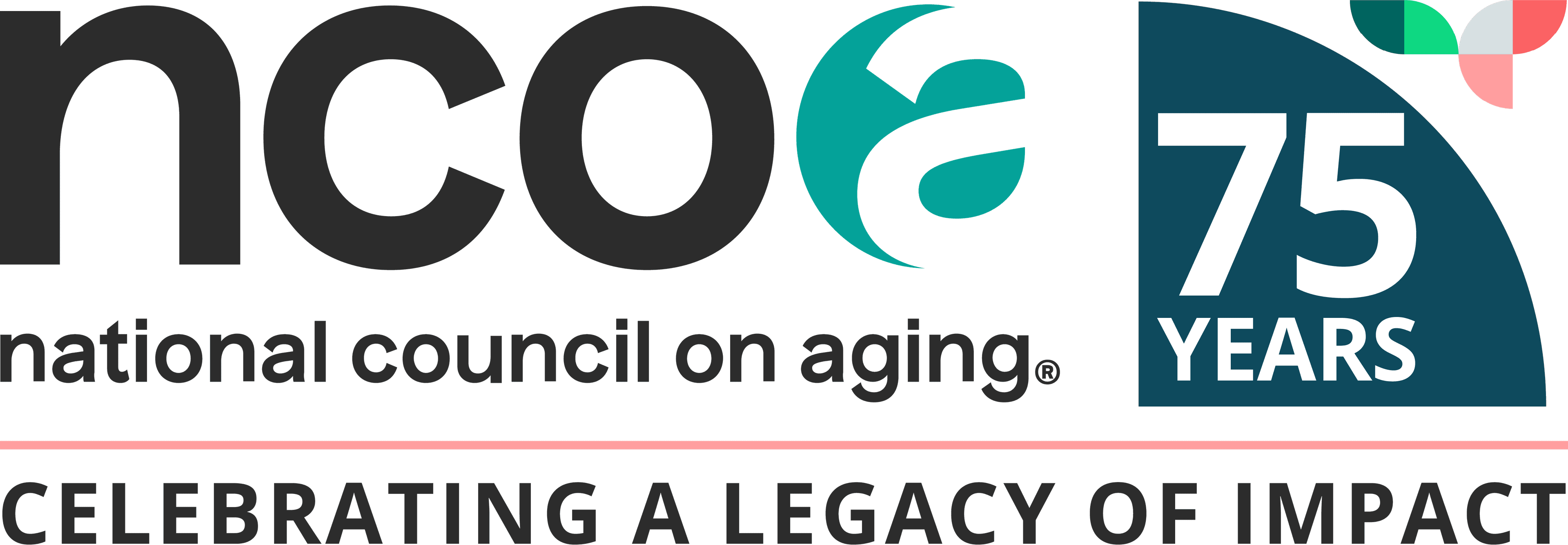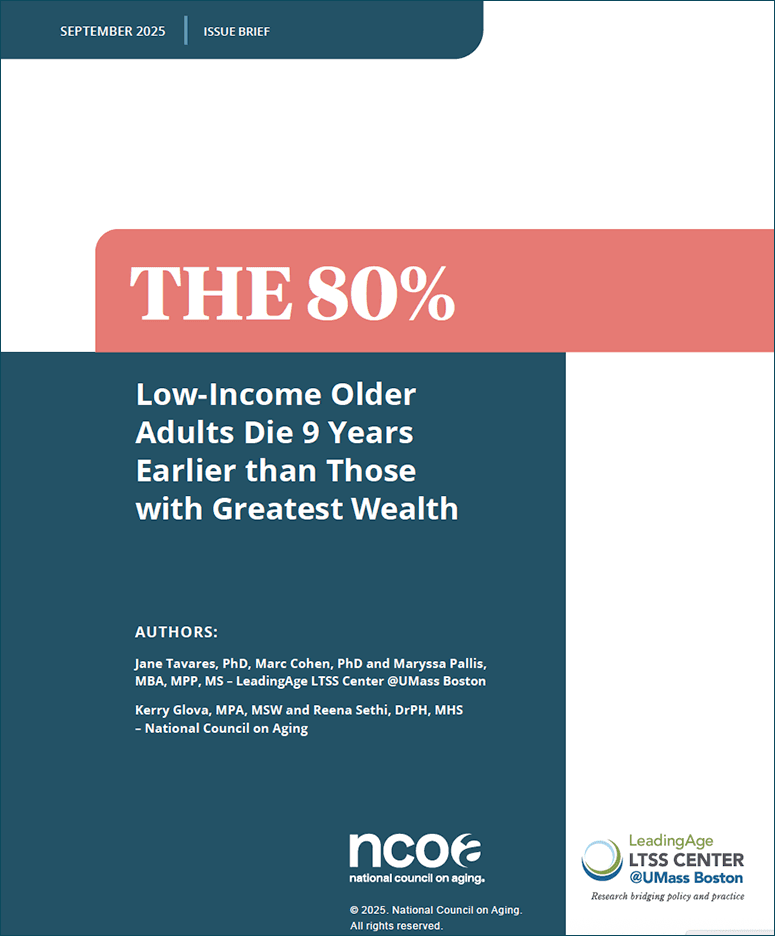
The latest report from the National Council on Aging (NCOA) and LeadingAge LTSS Center @ UMass Boston reveals a stark reality: Older adults with the fewest financial resources die, on average, nine years earlier than those with the greatest wealth.
“Low-Income Older Adults Die 9 Years Earlier than Those with Greatest Wealth,” which draws on nationally representative data from the Health and Retirement Study, highlights the widening wealth gap among Americans age 60+ and the devastating impact of that gap on health and longevity.
“It is shocking and unacceptable that in the United States in 2025, poverty steals almost a decade of older Americans’ lives,” said Ramsey Alwin, NCOA President and CEO.
Millions of older Americans who worked hard and played by the rules are dying early simply because they don’t have sufficient financial resources. This is a call to action to change our policies and systems to ensure that every person can enjoy the gift of longevity—not just the wealthy.”
Analyzing data from 2018 to 2022, researchers found:
- Wealth is strongly associated with longevity.
Mortality rates among older adults in the bottom 60% of wealth were nearly double those of older adults in the top 20%. In fact, those in the bottom 20% of wealth died on average nine years earlier than those in the top 20%. - Millions of older adults remain financially insecure.
Over 19 million (45%) older adult households do not have the income needed to cover basic living costs based on cost-of-living data from the Elder Index. And 80%, or about 34 million households, are unable to weather a major shock such as widowhood, serious illness, or the need for long-term care.
In the report's conclusion, researchers said, "The future of aging in America will likely be defined by an ever-widening inequality in both financial status and mortality, deepening the divide between the majority of older Americans (the 80%) and the top 20%."
Financial instability for U.S. older adults is too common
Our 2024 updated analysis of data from the Health and Retirement Study found living independently in the community without some assistance is out of reach for most older adults. Nearly 50% of adults 60 and older had household incomes below the Elder Index value for where they lived. This means their average income was below the standard needed to afford basic needs. This was a nearly 5% increase in 2020 compared to data from just two years earlier.
"Financial insecurity has largely remained unchanged for those already most at-risk: in 2020, those in the bottom 20% had no wealth, and those in the next three quintiles (21% to 80%) saw a decrease in the value of their financial assets from 2018," according to the 2024 analysis. "Financial patterns over the next several years would need to improve dramatically in order for most older Americans to maintain economic security in the face of rising living costs and increasing risks of financial shocks. While COVID-19 health and employment shocks may have contributed to the decline seen between 2018 and 2020, even if there is a return to modest improvements in 2022, the vast majority of older adults remain at financial risk."
U.S. wealth gap widening: 47 million older American households facing financial risks
Our 2023 updated analysis revealed that most older Americans continue to lack the resources that would allow them to weather a "financial shock" such as a significant long-term care need, health issue, or loss of income due to divorce or widowhood. The analysis of 2018 data previously found that 80%—or 47 million households with older adults—are financially struggling today or are at risk of falling into economic insecurity as they age.
The updated analysis found that despite older adults' preference to age in place, 60% would be unable to afford two years of in-home long-term services and supports. And 45% of people 60 and older had household incomes below the Elder Index1 value for their geography. In other words, their average income was below what they needed to afford basic living needs.
The true scope of financial insecurity in retirement
To better understand the financial landscape of older Americans, researchers at NCOA and the LeadingAge LTSS Center @UMass Boston analyzed data from the Health and Retirement Study, a longitudinal panel study that surveys a representative sample of approximately 20,000 people in America, supported by the National Institute on Aging and Social Security Administration.2
The analysis discovered that 80% of households with older adults—or 47 million—are financially struggling today or are at risk of falling into economic insecurity as they age. And this trend is worsening over time, as 90% of older households experienced decreases in income and net value of wealth between 2014 and 2016.
Four ways to help retirees make their money last
Combined together, longer lives and lower savings are fueling a retirement security crisis for millions of Americans. It is worsened by inflation, rising health care costs, and the fact that someone turning age 65 today has almost a 70% chance of needing some type of long-term care services and supports in their lifetime.3 Long-term care is expensive and not covered by Medicare.
This white paper by NCOA, LeadingAge LTSS Center @UMass Boston, and Nationwide offers four ways to help retirees make their money last in retirement.
More about these research findings
- NCOA press release: 80% of Older Adults Face Financial Insecurity
- NCOA press release: 80% of Older Americans Cannot Pay for Long-Term Care or Withstand a Financial Shock
Sources
1. UMass Boston. Elder Index. Measuring the income older adults need to live independently. Found on the internet at https://elderindex.org/
2. University of Michigan institute for Social Research. Health and Retirement Study. Found on the internet at https://hrs.isr.umich.edu/
3. U.S. Administration for Community Living. How Much Care Will You Need? Found on the internet at https://acl.gov/ltc/basic-needs/how-much-care-will-you-need
This publication was supported by the Administration for Community Living (ACL), U.S. Department of Health and Human Services (HHS) as part of a financial assistance award totaling $14,707,650.00 with 100 percent funding by ACL/HHS. The contents are those of the author(s) and do not necessarily represent the official views of, nor an endorsement, by ACL/HHS or the U.S. Government.





